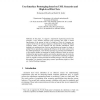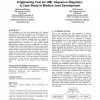19 search results - page 1 / 4 » Deriving Prototypes from UML 2.0 Sequence Diagrams |
ISIM
2007
13 years 6 months ago
2007
Executable prototypcs generatcd on early stages of software development bring many benefits, first of all they help to develop and validate systcm's spccification. The paper p...
QEST
2008
IEEE
13 years 11 months ago
2008
IEEE
The UML profile for Modeling and Analysis of Real Time and Embedded systems (MARTE) provides a powerful, standardised framework for the specification of non-functional propertie...
VISSOFT
2005
IEEE
13 years 10 months ago
2005
IEEE
Sequence diagrams are commonly used to represent object interactions in software systems. Reverse-engineered sequence diagrams, which are constructed from existing code, are becom...
APN
2000
Springer
13 years 9 months ago
2000
Springer
: In this paper, we suggest a requirement engineering process that generates a user interface prototype from scenarios and yields a formal specification of the system in form of a ...
PPPJ
2006
ACM
13 years 10 months ago
2006
ACM
The development of a tool for reconstructing UML sequence diagrams from executing Java programs is a challenging task. We implemented such a tool designed to analyze any kind of J...


